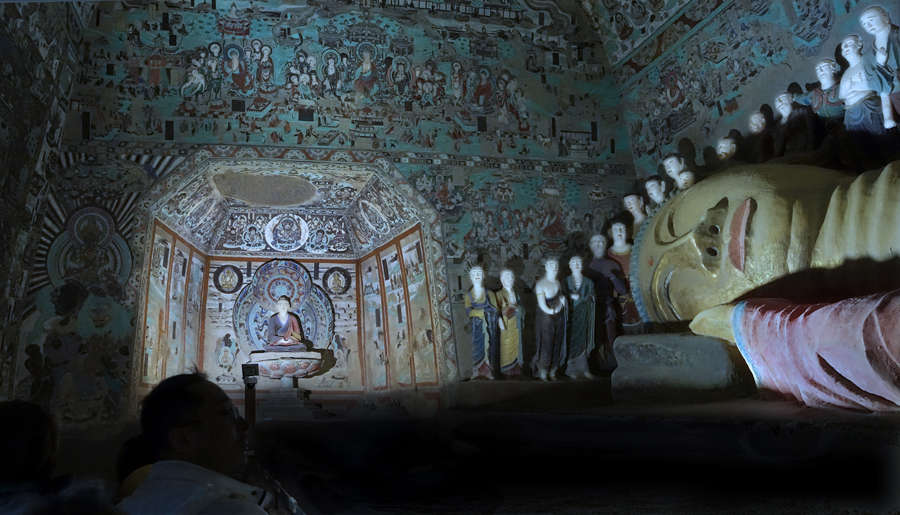China beefs up cultural relic protection with digital technology
Mogao Grottoes, a world cultural heritage site in Dunhuang of Gansu province. It has 735 caves, 2,415 colored clay statues and 45,000 square meters of murals, making it the largest and richest art treasure trove in the world. [Photo by Ren Shichen/cpanet.org.cn]
In 1900, a great discovery was made at the Mogao Grottoes, a UNESCO World Heritage site in Dunhuang, Northwest China's Gansu province. A small chamber later dubbed the Library Cave was opened for the first time in hundreds of years, revealing more than 60,000 cultural relics, including a wide range of manuscripts dating from the 4th century to the 11th century.
For thousands of years, while dynasties changed and wars raged outside, this cave measuring less than 8 square meters, seemed to be lost in time, fortunately preserving its store of historical treasures. It was one of the most important archaeological discoveries in the 20th century.
On Tuesday, an interactive digital platform called the "Digital Library Cave" was launched, featuring a virtual duplication of the Library Cave, employing digital technology to revive the relics for the benefit of both researchers and the general public.
Jointly developed by the Dunhuang Academy and leading Chinese tech firm Tencent, the platform uses advanced gaming technologies to reproduce the historical scene of the Library Cave as it was more than 100 years ago. Virtual visitors can engage in role-play to travel to ancient dynasties and interact with eight historical figures, thereby immersing themselves in the culture of Dunhuang.
Zhao Xiaoxing, director of the literature research institute at the Dunhuang Academy, said that researchers made deliberate studies of literature, architecture and music related to the cave before establishing the digital platform.
Since the 1980s, the Dunhuang Academy has sought to use digital technology to ensure the permanent preservation and sustainable use of cultural relics. Seven years ago, it launched "Digital Dunhuang," a website that offers virtual views of the Mogao Grotto caves. It employed massive data resources, such as photos, video clips, archive materials and a 360-degree view of the millennium-old caves, sharing the wonders of the site with a global audience.

On April 18, an interactive digital platform called the "Digital Library Cave" was launched, featuring a virtual duplication of the Library Cave, employing digital technology to revive the relics for the benefit of both researchers and the general public.[Photo provided to chinadaily.com.cn]
In June 2022, the Dunhuang Academy and Tencent established a joint laboratory to explore new technologies and modes of cultural heritage display through the application of digital technologies. The Digital Library Cave is one of the first projects to emerge from the lab.
Su Bomin, director of the Dunhuang Academy, said more efforts will be made to explore new ways of displaying cultural relics, offering the public more immersive cultural experiences to promote and develop the Dunhuang culture.
Such moves reflect a broader effort by China in recent years to beef up the protection of cultural relics, using digital technology as a new means of permanently preserving these intangible resources.
Another good example is an interactive digital platform of virtual oracle bone inscriptions that was made accessible to the public on Thursday. The WeChat mini program named "Great Oracle Bones" uses digital technology to present a three-dimensional image of carved oracle bone inscriptions. By clicking on the scripts on the platform, users can immediately discover the corresponding modern Chinese characters and definitions.
"The mini program aims to enhance people's understanding of the oracle bone inscriptions and arouse their awareness of researching and protecting the early Chinese scripts," said Wang Chaoyang, chief digital architect of the sustainable social value division of Tencent, one of the developers of the platform. Oracle bone inscriptions, or Jiaguwen, are an ancient Chinese script named after their inscriptions on tortoise shells and animal bones. They are a primitive form of Chinese character writing and the oldest fully-developed characters in China.
So far, about 150,000 pieces of oracle bone inscription have been discovered, of which more than 35,000 were excavated by archaeologists. Researchers have identified more than 4,000 characters and deciphered one-third of them. "The oracle bone inscriptions that have not been discovered and decoded are all hard nuts to crack, and the booming artificial intelligence technologies can be beneficial to the interpretation of oracle bone scripts," said Guo Xudong, dean of oracle bone scripts research institute of Anyang Normal University.
Related articles
-
 Treasures unearthed in Gansu shine light on Dunhuang culture
Treasures unearthed in Gansu shine light on Dunhuang cultureMore
-
 Archaeologists uncover branches at relic site in central China's Henan
Archaeologists uncover branches at relic site in central China's HenanMore
-
 The Bronze Hall of Sanxingdui Museum Reopens
The Bronze Hall of Sanxingdui Museum ReopensMore
-
 Secrets emerge in Northwest China from the mists of time
Secrets emerge in Northwest China from the mists of timeMore
-
 Cultural Relic: Pottery Figurine of Horsemen
Cultural Relic: Pottery Figurine of HorsemenMore
-
 Unusual bronze tiger bowl shown at Shanxi Museum
Unusual bronze tiger bowl shown at Shanxi MuseumMore

